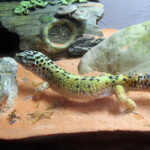The gargoyle gecko is a docile reptile that is easy to hold. When fully grown, it weighs 60 grams and is 10 inches from the tip of the tail to the snout. They can live up to 20 years with proper care. Pet owners should focus on a few things when caring for one of these geckos. The housing, environmental conditions, and diet are three important factors that contribute to the well-being of the gargoyle.
Enclosure
Gargoyle geckos require a lot of space to live comfortably in captivity. A 20 gallon long aquarium tank is large enough to accommodate one or two. A 40 gallon tank is recommended for breeding these geckos. The tank should be covered with a screen to prevent the geckos from climbing out.
The gargoyle type of gecko can’t stick to glass, but they can climb on branches and logs that are placed in the tank. Make the tank as green as possible. In the wild, these types of geckos cling to the shrubbery near the forest floor.
Temperature
The enclosure should have the proper environmental conditions. The temperature is a very important factor in proper gargoyle gecko care. A temperature between 65 and 80°F is ideal. Anything over 85°F is stressful, and short term exposure at 90°F can be lethal. The upper 50s is the bottom temperature range for these geckos.
A basking area that is warmer than the surrounding area can be implemented with a heat lamp. For breeding geckos, the incubation temperature for gecko eggs is about 75°F.
Diet
Another important factor in caring for a gargoyle gecko is providing an adequate diet. They should be fed a diet that consists of crickets, roaches, and pinky mice. Only feed the gecko once a week.
It is also recommended to give the gargoyle gecko a powdered drink prepared from crested gecko diet. It consists of several ingredients including dried honey, whey protein, whole dried egg, and alfalfa leaf meal. Mix one part powder with two parts water by volume. It should have a milkshake consistency.
You can also provide your gecko with calcium supplements in the form of dusted crickets.
Behavior
Gargoyle geckos of different sizes and male geckos should not be housed together — they will fight and may lose their tail or even die. Even though geckos can grow their tail back, it is important to look for signs that something is wrong with the gecko. Taking it out of the tank and placing it in an open area is one way to see if the gecko is healthy. It should walk at a brisk pace if it is healthy. If they hardly move, something might be wrong. If the gecko is injured or doesn’t eat, take it to a vet.
Keeping a gargoyle gecko as a pet is a huge responsibility, the same that comes with all types of pet lizards . There are several things to consider when caring for one of these geckos including the housing requirements, environmental conditions, and diet. Keep an eye on the gecko regularly to ensure it is eating properly and is healthy.
Reference:
Gargoyle Geckos Care – Rapture Reptiles
Gargoyle Gecko Care – Pangea Reptile
“Repashy Crested Gecko Diet.” Pangea Reptile

